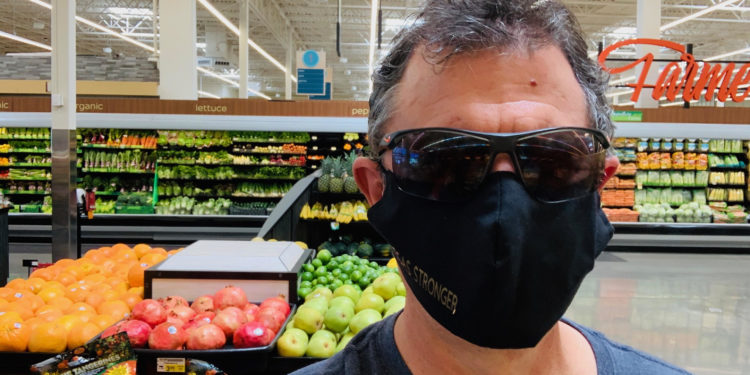The coronavirus disease (COVID-19) in 2020 has caused a dramatic shift in behavioral changes throughout society in the United States and globally. Our heightened awareness of COVID-19 restrictions is affecting how we interact with one another by social distancing, stay-at-home limitations, and the use of personal protective equipment (PPE) to enhance public health and safety. The current community pulse and the wearing of PPE may create a greater risk to law enforcement when identifying pre-assaultive behaviors of an offender, while mitigating risks for everyone wearing PPE.
A New Set of Challenges
Every day while protecting and serving society, first responders face innumerable challenges in adapting to new situations across our country. In the current pandemic, firefighters, law enforcement officers (LEOs), and paramedics continue to put themselves in harm’s way, placing others before themselves in facing an invisible threat (COVID-19) or when encountering a potentially volatile offender who has an exposed or a hidden weapon. While community members are adapting to the utilization of PPE and practicing social distancing, law enforcement professionals continue to adjust to ever-changing societal rules to enhance public safety for everyone’s protection.

Strategies recommended by the Centers for Disease Control (CDC) for businesses [1] to decrease the risk of the virus spreading have caused nation-wide industry to become creative in applying these changing guidelines. Commerce has varied in their approach to serving clientele by closing establishments entirely, limiting customers to curbside or sidewalk service, and regulating the number of people within a location. An interesting shift in behavioral change is innovations of organizations such as: creating physical barriers between customers and employees, designing traffic patterns, posting cautionary signs on entry/exit points, or assigning an employee to monitor foot traffic. The public seems to be more self-conscious and cautious within their surroundings in relation to their proximity to others. This may be due to the number of COVID-19 cases and deaths highlighted by the mainstream media with the repeated message of six feet in social distancing to reduce the spread.
During the pandemic, not only are proxemics a real concern for the population, it is especially significant to public safety personnel in mitigating potential threatening behaviors which may endanger lives. To enhance public and peace officer welfare, experienced law enforcement professionals and trainers have advocated that safe distance is a variable number depending on the behaviors, circumstances, and potential threat of the subject(s) involved. With anyone wearing PPE, specifically masks, it creates new challenges for law enforcement when identifying people and potentially assaultive behaviors; recognizing criminal conduct; initiating stops; interpreting conversations; and reacting to police presence. Actions or intentions may be misinterpreted due to muffled speech through a mask or an individual may become fearful when an officer closes the distance. Although PPE is essential to people and officer safety, it may pose a risk during arrests, detentions, service calls, and traffic stops.
Statistics on Peace Officer Assaults
The FBI’s Criminal Justice Information Services Division (CJIS), Uniform Crime Reporting (UCR) Program collects data from more than 18,000 participating law enforcement agencies [2]. In 2018, there were 58,866 assaults reported from 11,788 agencies contributing information to the FBI’s UCR Law Enforcement Officers Killed and Assaulted (LEOKA) Annual Report. Of these reported assaults, there were 18,005 (31%) reported LEOs to have sustained injuries [3]. This data suggests approximately 65% of the more than 18,000 agencies reporting assault information. If 100% of the agencies reported statistics involving assaults upon peace officers, the numbers of assaults involving our nation’s guardians would be significantly higher.
Distances LEOs Killed with Firearms (30-year period):
A 2016 article published in the FBI Bulletin What is a Safe Distance? [4] explains the proximity between the LEOs and offender(s) when LEOs were murdered. During this period, 1,665 LEOs were slain with firearms for a total of 1,880 victim officers killed in-the-line of duty. An excerpt from the article explains proximity:
“In the 30 years between 1985 and 2014, the trend rose slightly higher.[4] During this period 69.7 percent of officers killed with firearms in the line of duty were murdered within 0 to 10 feet of perpetrators. Offenders shot approximately half—50.9 percent—of these officers within 0 to 5 feet. The statistics demonstrate that the number of officers who die decreases as the distance between the officer and offender incrementally increases to 50 feet or more.”
Distances LEOs Killed with Firearms (10-year period):
Between 2010 through 2019, there were a reported 471 victim officers killed by offenders armed with firearms. Various calibers of handguns were used in 73% of these felonious deaths involving firearms. There were several reported distances ranging from 0 to 5 feet to over 50 feet. There were 39% of the LEOs murdered by perpetrators within 0 to 5 feet. Of these law enforcement deaths, 18% were killed by offenders in the range of 6-10 feet. Of these deaths, 10% reported the distance was unknown and 6% of the agencies had not reported the distance [5].

After reviewing officer safety incidents and FBI LEOKA data, it was determined that a number of line-of-duty attacks that produce serious bodily injury and death may have been prevented. A high percentage of these incidents involved handguns with the offenders in close proximity when they were murdered or assaulted LEOs. It is imperative that law enforcement field personnel, front line supervisors, trainers, and command personnel receive training that addresses the increases in ambush attacks, peace officer assaults, and use of force incidents involving criminals, the homeless and mentally ill populations, and edged weapons. Tactical considerations and use of force options must involve best practices that are contemporary, legal, and understood. Awareness education shall encompass the impact of COVID-19 on operations, the potential of not recognizing criminal distractions and pre-assaultive behavior, and the failure to have frequent reality-based scenario training where the trainee experiences shock, startle, and surprise. These issues are critical for the health and wellness of law enforcement personnel.
Pre-assault Indicators:
To significantly enhance officer safety during any policing encounter, the effective recognition of criminal behavior and pre-assaultive cues is based on the peace officer abilities to read the scene (RTS) and react to my presence (RTMP). Officer safety skills are perishable and diminish over time without ongoing learning and practice, peace officers must strive to correctly interpret a single act or a combination of behavioral and physiological cues that indicate the probability of a crime or an attack. The following is a non-inclusive list of pre-assault indicators meant to be thought-provoking for on and off-duty law enforcement activities:
- Behaviors: aggressive or threatening demeanor, argumentative, contempt, distrust, hate, hostility, non-compliance, non-congruence with communication, and spitting
- Body language: bladed, defensive, or fighting stance, clenched fists, clothing removal, defensive posture, and exaggerated moving or stretching limbs
- Communications: (nonverbal and verbal) gestures, hand signs, signals, and threatening statements with a lack of reverence for human life
- Emotions: anger, despair, fear, sadness, and suicidal
- Head/facial movements: animated gestures, blank stare, clenching the jaw, and scanning the area
- Physical positioning: closing the distance, moving to cover, seeking a position of advantage, and triangulating
- Physiological cues: breathing changes, elevated pulse, and sweating
Unfortunately, officer safety statistics cannot be quantified for the countless LEOs who recognized unsafe behaviors, maintained situational awareness, and prevented a violent assault. By learning from previous incidents throughout the United States involving assaultive behaviors, these violent attacks, injuries, or deaths can be reduced.
Pre-assault Indicators Involving Multiple Subjects:
There is a cross-over in assessing pre-assaultive behaviors with one or more offenders. The following three trends repeatedly surfaced when discussing attack behaviors involving multiple assailants with experienced LEOs. This list is non-inclusive with the intention to create interactive discussion in recognizing potential assaults:
- Methods of communication: gestures, sign language, signaling other attackers, and verbal and nonverbal actions
- Physical positioning and changing proximity: approaching, circling, flanking, moving away slowly or quickly, and triangulating
- Distraction techniques: arguing, challenging to fight, citing a bias, gender, or racial concern, feigning to understand commands, one is moving while the other is talking, questioning a legal right to detain or search, and threatening force
Other Associated Factors:
Other factors must also be taken into consideration when assessing pre-assault behaviors. The following may be predictive of potential violent behavior that may include, but are not limited to:
- Court mandates: parole, probation, and warrants
- Criminal activity: in progress or reasonable suspicion to believe
- Criminal histories: violence against police and other crimes of violence
- Desire to remain free: willingness to fight, flee, or kill for freedom
- Firearms: immediate access and concealment of a weapon (i.e. asymmetrical gait, bracing the weapon when running, conspicuous clothing, quick adjustment when climbing a curb or walking, and upper body shift)
- Hatred of LEOs: retaliatory behavior
- Mental health issues: documented and display of symptoms
- Turnstile justice systems: early prisoner release programs such as COVID 19
- Under the influence: alcoholic beverage(s) or drug(s) (i.e. prescription or illegal)
- Weapons: concealed, disguised, or improvised (i.e. blunt object, edged, explosive, and firearm)
Mindset and Behavior Study:
The FBI’s 2016 The Assailant Study (Mindsets and Behaviors) [6] examined 50 incidents involving attacks against law enforcement where peace officers were killed. Originally, there were 53 incidents considered with 64-officers killed. Their conclusions identified common trends as well as two primary contributing factors:
…” The common trends identified were (1) the expressed desire to kill law enforcement, and (2) the desire to remain free. The contributing factors identified were (1) the singular narrative that portrays the officer involved as guilty in traditional and social media and the subject as the victim, and (2) the recent criminal justice reform initiatives that reduce prosecutions and incarceration of criminals, specifically drug offenders, which has the effect of putting criminals back on the street with an attitude of “beating the system.”
The Fine Line of Timely Assessing Criminal Behavior:
Today’s peace officer must immediately determine if behavior demonstrates a threat, or a need for humanitarian aid or medical care. After interviewing over 1,000 LEOs involved in critical and non-deadly/deadly use of force incidents, and studying hundreds of policing situations where officers were seriously injured or killed, the author concluded that two skills, reading the scene and reacting to my presence are essential best practices for safety.

Encounters with people require an instantaneous assessment of behavioral cues, compliance levels, and threats. It is imperative for peace officers to recognize the detained person’s reactions to commands, directions, or requests. Once the individual displays distraction and non-compliance counter strategies, the officer must decide if tactics need to be escalated to a safer defensive option and precise commands. Failure to achieve this safety practice puts the officer in a position of disadvantage and at risk of a potentially serious or deadly attack.
Whether interpreting information (i.e. operational, tactical, or strategic intelligence) from people, various personal observations, or listening to the radio, officers must constantly evaluate any actions that could involve pre-assault indicators. Over decades, terms such as danger signs, red flags, gut instincts, threats, and violence potential, have been described by assaulted LEOs. Many of these peace officers wanted others to learn from their experiences, stressing that complacency and unawareness resulted in their attacker gaining the upper hand.
To prevent complacency, the number one enemy of law enforcement, officers need to maintain a position of advantage when dealing with any display of potential criminal or violent behavior. This is achieved by using cover and greater distance, with the presence of backup to gain a tactical edge. Dangerous criminals are to be placed in a position of disadvantage based on the policing activity,
Law enforcement professionals must remain hypervigilant of the proximity between themselves and a potentially volatile offender. As the proximity closes between the LEO and subject, the officer’s ability to react quickly and effectively to threatening behaviors may diminish. Recognizing pre-assault indicators can stop attacks, avoid injuries, and prevent deaths.
Maintaining an Officer Safety Mindset:
Considering the pandemic, agencies may be faced with budgetary shortfalls that might eliminate critical personnel positions. This could reduce services and put officers at risk in back-up situations. Leaders of public safety agencies must adapt to societal shifts, while supervisors and trainers remain aware of local, regional, state, and national trends related to officer-safety [7], while monitoring concerns such as COVID-19 [8].
Everyone in law enforcement is responsible for influencing, maintaining, and practicing ethical, legal, and proper policing attitudes. Best law enforcement practices involve constant situational awareness, effective information gathering, critical decision-making skills, communication and de-escalation abilities, safe tactical procedures, and flexible use of force options. When first responders, leaders, supervisors, and trainers demonstrate with integrity a passion for community policing, they have achieved the greatest risk-management for safety and well-being of the civilian and sworn law enforcement profession.
Always remember, a peace officer never knows when the next moment in time will require the best that they can be.
Resources:
[1] U.S. Center for Disease Control and Prevention, Interim Guidance for Businesses and Employers Responding to Coronavirus Disease 2019 (COVID-19), May 2020, accessed 05/14/2020, https://www.cdc.gov/coronavirus/2019-ncov/community/guidance-business-response.html
[2] United States Department of Justice (USDOJ), Federal Bureau of Investigation (FBI), Criminal Justice Information Services Division (CJIS), Uniform Crime Reporting (UCR), accessed May 19, 2020, https://www.fbi.gov/services/cjis/ucr/
[3] USDOJ FBI UCR LEOKA Program, Law Enforcement Officers Assaulted Type of Weapon and Percent Injured, 2009–2018, accessed May 19, 2020, https://ucr.fbi.gov/leoka/2018/tables/table-85.xls
[4] Young, Marcus, What Is a Safe Distance? Officer Survival Spotlight, FBI Law Enforcement Bulletin, July 2016.
[5] USDOJ FBI UCR LEOKA Program, Officer Killed with Firearm, Type of Firearm by Distance Between Victim Officer and Offender, 2010–2019, accessed May 19, 2020, https://ucr.fbi.gov/leoka/2019/topic-pages/tables/table-33.xls
[6] FBI, Office of Partner Engagement, The Assailant Study-Mindsets and Behaviors, accessed May 19, 2020, PDF link through: https://www.lawofficer.com/the-assailant-study-mindsets-and-behaviors/
[7] USDOJ FBI UCR LEOKA Program, accessed 05/19/2020 https://www.fbi.gov/about-us/cjis/ucr/leoka-resources.
[8] Institute for Health Metrics and Evaluation, COVID-19 Projections, accessed May 19, 2020, https://covid19.healthdata.org/united-states-of-america
Note 1: As of May 24, 2020, the 2019 FBI UCR LEOKA assault data is pending.
Note 2: All numerical notations and percentages are rounded to the nearest percentage. Please refer to the direct resources for statistics, data tables, and further explanation within the annual publications through the DOJ FBI UCR LEOKA Program.
Authors:

